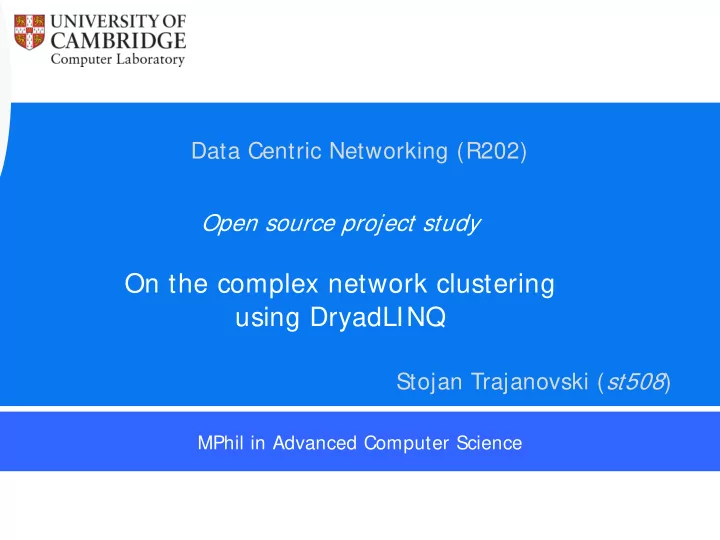

Data Centric Networking (R202) Open source project study On the complex network clustering using DryadLINQ Stojan Trajanovski ( st508 ) MPhil in Advanced Computer Science
Motivation Why going parallel in complex networks analysis? • Online social networks, Internet graph o millions of users (Facebook, Twitter …) o increased computational complexity • Why is prospective? o some actions are fully independent o increased hardware performance - multi-core - network clusters, global cloud clusters Data Centric Networking (R202) presenter: Stojan Trajanovski (st508) 2
Motivation Why using PLINQ/DryadLINQ? • Inherited LINQ behaviour o declarative and imperative programming o T-SQL syntax in your code - no more SQL server store-procedures - optimized performance - inherited SELECT, GROUP/ORDER BY • + Dryad/Parallel processing o optimized job management Data Centric Networking (R202) presenter: Stojan Trajanovski (st508) 3
Why not (mainly pure technical reasons)? • problems even with Microsoft concepts o requires .NET environment anyway o evaluated only on newest Microsoft OSs o head node: - > Windows Server ’08 OS (problems with ‘03) - more than 500G HD, 8 MB memory o computational nodes (at least Windows 7) o no Windows Azure support � o Someone mentioned Linux/MacOS? ☺ Data Centric Networking (R202) presenter: Stojan Trajanovski (st508) 4
My application/solution? Using PLINQ/DryadLINQ for network clustering? • K-means clustering o parallel performs better o the approach: - parallelize the method o the results - significantly better time performance o TO DO - more clustering approaches, comparison … Data Centric Networking (R202) presenter: Stojan Trajanovski (st508) 5
Some plots Parallel vs. non parallel LINQ ( dataset: ) different values of N= { 100,200,500,1000} Data Centric Networking (R202) presenter: Stojan Trajanovski (st508) 6
o Questions?? o Short Discussion - still work in progress ... Data Centric Networking (R202) presenter: Stojan Trajanovski (st508) 7
Recommend
More recommend